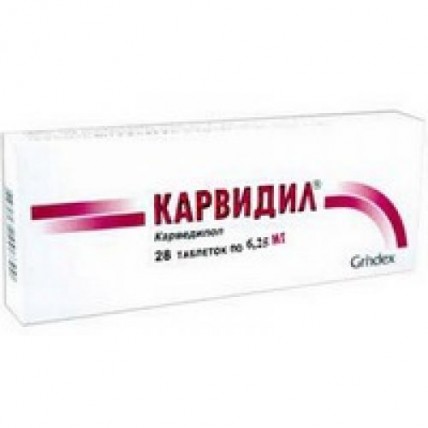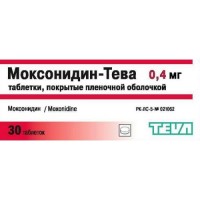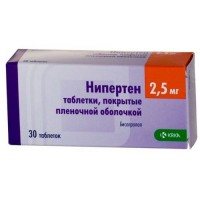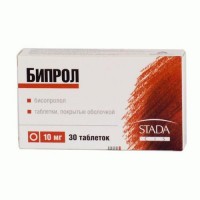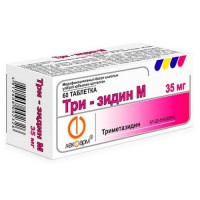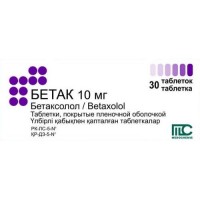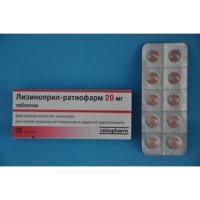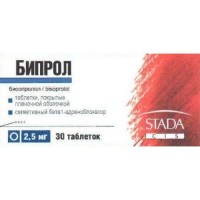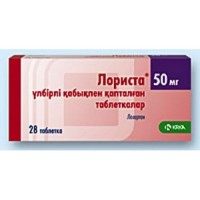CARVIDIL® (Carvedilol) 6.25 mg (28 tablets)
- $15.30
The instruction for medical use
of KARVIDIL® medicine
the Trade name
of Karvidil®
the International unlicensed
name Karvedilol Lekarstvennaya a form
of the Tablet of 6.25 mg, 12.5 mg or 25 mg
Structure
One tablet contains
active agent – karvedilol 6.25 mg, 12.5 mg or 25 mg,
excipients: lactoses monohydrate, cellulose microcrystalline, krospovidon, silicon dioxide colloidal, anhydrous, magnesium stearate, ferrous oxide yellow E 172 (for tablets of 6.25 mg and 12.5 mg), ferrous oxide red E 172 (for tablets of 12.5 mg).
Description
of the Tablet of 6.25 mg: tablets of yellowish color with dark yellow impregnations round biconvex with risky on one party.
Tablets of 12.5 mg: tablets of pink color with dark pink impregnations round biconvex with risky on one party.
Tablets of 25 mg: tablets of white color round biconvex with risky on one party.
Pharmacotherapeutic group
Beta blockers. Alpha and beta blockers. Karvedilol.
The ATX C07AG02 code
the Pharmacological
Pharmacokinetics Later properties of intake quickly and almost is completely soaked up in digestive tract. TCmax in plasma – 1 h. Bioavailability – 25%. Communication with proteins of plasma – 98‑99%. Distribution volume – about 2 l/kg. It is metabolized in a liver (has effect of the first passing through a liver). Metabolites possess the significant antioxidant and adrenoceptor blocking action. T½ – 6-10 h. Plasma clearance – 590 ml/min. It is removed, generally with bile. At patients with an abnormal liver function the bioavailability can increase up to 80%. Gets through a placental barrier, it is allocated with breast milk.
At elderly patients the concentration of a karvedilol in plasma increases approximately by 50% therefore dose adjustment (reduction half) for this age group is required.
At patients with disturbances of functions of a liver by 4 times the bioavailability of a karvedilol increases, and the maximum concentration in plasma – in 5 times more therefore this group of patients also requires dose adjustment towards reduction.
At patients with hypertensia and a renal failure from average to heavy degree (clearance of creatinine & lt, 30 ml/min.) increase in concentration of a karvedilol in plasma approximately for 40-50% was observed that also demanded dose adjustment.
The pharmacodynamics
Blocks the альфа1st, the бета1st and beta2-adrenoceptors, has vazodilatiruyushchy, anti-anginal and antiarrhytmic effect. The Vazodilatiruyushchy effect is connected mainly with blockade of alfa1-receptors. Thanks to a vazodilatation reduces the general peripheric resistance of vessels. Has no own sympathomimetic activity, has membrane stabilizing properties. The combination of a vazodilatation and blockade of beta adrenoceptors results in the following effects: at patients with arterial hypertension the decrease in arteralny pressure is not followed by increase in the general peripheric resistance of vessels, the peripheral blood stream does not decrease (unlike beta blockers). Heart rate decreases slightly. At patients with coronary heart disease has anti-anginal effect. Reduces before - and an afterload by heart. Has no significant impact on lipidic exchange and the maintenance of K+, Na + and Mg 2+ in plasma. At patients with dysfunctions of a left ventricle or a circulatory unefficiency favorably influences hemodynamic indicators and improves fraction of emission and the sizes of a left ventricle. Has antioxidant effect, eliminating free oxygen radicals. Reduces risk of death of patients with dekompensirovanny heart failure (by 65%) and the frequency of hospitalization (for 38%). In moderate chronic heart failure reduces risk of death by 28%. The efficiency is more significant at patients with tachycardia (heart rate more than 82 beats/min) and low fraction of emission (less than 23%). The therapeutic effect is shown at an ischemic etiology of chronic heart failure and at patients with a dilatatsionny cardiomyopathy.
Indications
- arterial hypertension
- chronic stable stenocardia (preventive therapy)
- chronic heart failure (as a part of complex therapy)
the Route of administration and doses
Inside, washing down with enough liquid.
In arterial hypertension – 12.5 mg once a day in the first 2 days, then on 25 mg once a day, with possible gradual increase in a dose with an interval not less than 2 weeks. The maximum daily dose – 50 mg, accepting all dose at once or dividing it into 2 receptions.
In stable stenocardia – 12.5 mg 2 times a day in the first 2 days, then on 25 mg 2 times a day. If necessary, observing intervals not less than 2 weeks, the dose can be increased gradually. The maximum single dose – 50 mg. The maximum daily dose – 100 mg.
In chronic heart failure (against the background of the picked-up therapy by foxglove drugs, diuretics and inhibitors of angiotensin-converting enzyme) – begin with 3.125 mg 2 times a day within 2 weeks, then (at good tolerance) this dose is increased to 6.25 mg by 2 times a day, then – up to 12.5-25 mg 2 times a day. At body weight less than 85 kg – the maximum single dose makes 25 mg, the maximum daily dose – 50 mg.
At body weight more than 85 kg – the maximum single dose makes 50 mg, the maximum daily dose – 100 mg.
If treatment is interrupted more, than for 2 weeks, then its resuming there begin with a dose 3.125 mg 2 times a day, with the subsequent increase in a dose.
Duration of a course of treatment and a dose are operdelyat by the attending physician.
Side effects
Often
- an asthenic syndrome (fatigue, weakness, fast fatigue), peripheral, orthostatic hypostases, allergic reactions, concern, a hypovolemia, fever
- bradycardia, orthostatic hypotension, arterial hypertension, faints, stenocardia, AV blockade, heartbeat, a stroke, disturbances of peripheric circulation (cold in palms and stupnyakh, a disease of peripheral vessels, strengthening of symptoms of the alternating lameness, Reynaud's syndrome)
- dizziness, a headache, a hypesthesia, vertigo, paresthesia, drowsiness, insomnia, a depression, oppressed mood
- diarrhea, nausea, vomiting, a melena, periodontitis, abdominal pains
- arthralgias, arthritis, myotonia, hypotonia of muscles, extremity pains
- cough, rattles, dispnoe, a fluid lungs, bronchial asthma (at predisposed patients)
- bronchitis, pneumonia, an upper respiratory tract infection, an infection of urinary tract
- a purpura
- lowering of the level of a prothrombin, thrombocytopenia
- a renal failure, an albuminuria, a hamaturia
- impotence
- increase in body weight
- a hyperglycemia, increase in level of creatinine, alkaline phosphatase, gamma glutaminetransferase, urea nitrogen of blood and residual nitrogen, a hypercholesterolemia, a gipertriglitseridemiya, a hyperuricemia, a hypoglycemia, a hyponatremia, a glycosuria, a hypervolemia, diabetes, loss of weight, a hyperpotassemia, anemia
- indistinct sight, irritation of eyes, a grippopodobny syndrome, extremity pains, reduction of a slezootdeleniye, development of gouty arthritis
Infrequently
- tachycardia
- a hypokinesia, excitability, disturbance of concentration of attention, consciousness disturbance, nightmares, sleep disorders, emotional instability, dryness in a mouth, perspiration
- a bilirubinemia
- anemia, a leukopenia
- the speeded-up urination
- the lowered libido
- skin allergic reactions (dieback, dermatitis, a small tortoiseshell, an itching), erythematous, makulopapulezny and psoriasis rashes, reactions of photosensitivity
- sonitus
Seldom
- full AV blockade, blockade of legs of a ventriculonector, ischemia of a myocardium, disturbance of cerebral circulation
- neuralgia, amnesia
- digestive tract hemorrhages, increase in activity of hepatic transaminases is possible (AsAT and AlAT)
- congestion of a nose, a bronchospasm, a fluid lungs, a respiratory alkalosis, an interstitial pneumonitis
- a pancytopenia and emergence of atypical lymphocytes
- incontinence of urine at women
- a constipation
- decrease in level of alpha lipoproteins of high density
- anaphylactic reactions, an alopecia, exfoliative dermatitis, Stephens-Johnson's syndrome, a toxic epidermal necrolysis, a polymorphic erythema
- deterioration in hearing
is Very rare
- a leukopenia
At patients with stagnant heart failure at increase in a dose of a karvedilol possibly aggravation of heart failure and a delay of liquid
of the Contraindication
- hypersensitivity to a karvedilol or to any excipient of drug
- bronchial asthma
- a bronkhospastichesky syndrome, chronic bronchitis, emphysema of lungs
- AV blockade of II, III degrees, a syndrome of weakness of a sinus node, the profound bradycardia (if there is no constant pacemaker)
- cardiogenic shock
- acute and dekompensirovanny chronic heart failure (the IV functional class on NYHA) at which intravenous administration of drugs of inotropic action
- arterial hypotension (systolic arterial blood pressure less than 85 mm Hg)
- heavy disturbances of peripheric circulation
- a disease of peripheral vessels
- simultaneous in/in administration of verapamil, diltiazem or other antiarrhythmic means (especially the I class)
- a metabolic acidosis
- simultaneous treatment by antagonists α1-рецепторов is necessary or α2‑рецепторов
- a pheochromocytoma
- a liver failure
- pregnancy, the lactation period
- children's and teenage age up to 18 years (safety and efficiency of use are not established)
- Printsmetal's stenocardia
- diabetes with ketoacidosis
- hereditary intolerance of a galactose, deficiency of Lappa lactase or malabsorption
of glucose galactose C by care
- diabetes, a hypoglycemia
- a hyperthyroidism
- a depression
- a myasthenia
- psoriasis
- the renal failure
Medicinal interactions
Is reported both about pharmakodinamichesky, and about pharmacokinetic interaction of beta blockers with other drugs.
Framakokinetichesky interaction
Digoxin: at simultaneous use karvedilol increases concentration of digoxin in blood serum approximately by 15% that leads to strengthening of the bradycardia caused by digoxin. Digoxin and karvedilol AV slow down conductivity that can result in additivity of their action. It is recommended to control concentration of digoxin in plasma at the beginning of use, at selection of doses or the termination of therapy karvediloly.
Cyclosporine: karvedilol can increase concentration of cyclosporine in plasma therefore it is necessary to reduce a cyclosporine dose. After the beginning of therapy karvediloly control of level of cyclosporine is recommended.
The drugs inducing or inhibiting P450 cytochrome enzymes: at simultaneous use with barbiturates and rifampicin, metabolism of a karvedilol amplifies that leads to reduction of its concentration in plasma.
In turn Cimetidinum, erythromycin, fluvoksamin and gidralazin slow down metabolism of a karvedilol, strengthening action of a karvedilol.
Aluminum hydroxide, holestiramin: at simultaneous use the absorption of a karvedilol is delayed that leads to reduction of its effect.
Pharmakodinamichesky interaction
Antidiabetic drugs, including insulin: karvedilol strengthens hypoglycemic action and masks or reduces the characteristic of a hypoglycemia warning signs, for example a tremor.
The drugs reducing the level of catecholamines: MAO inhibitors, reserpine can cause heavy bradycardia and enhance hypotensive effect of a karvedilol.
Verapamil, diltiazem and other antiarrhytmic drugs: at simultaneous use with karvediloly there can be heavy bradycardia or heart block. In case of an injection of verapamil the profound hypotension and an asistola is possible. Amiodaronum increases risk of developing of ventrikulyarny arrhythmias.
Clonidine: at simultaneous use with karvedily it is necessary to control blood pressure. In cases when it is necessary to stop simultaneous therapy by a clonidine, at first it is necessary to stop use of a karvedilol, several days later, gradually reducing a dose, stop therapy by a clonidine.
Ergotamine or ergometrine: simultaneous use with karvediloly strengthens reduction of peripheral blood vessels.
Antimalarial means: increase risk of appearance of the bradycardia caused karvediloly.
Sympathomimetic means: karvedilol can increase or reduce pressor effect of adrenaline (epinephrine). Long-term treatment karvediloly can reduce effect of adrenaline in case of desensibilizatsionny therapy.
Chlorpromazinum: simultaneous use of a karvedilol and Chlorpromazinum can cause increase in concentration of both drugs in plasma and to strengthening of their effects.
Antihypertensive drugs: karvedilol can strengthen effect of other at the same time applied antihypertensive drugs and action of such means which cause by-effects, characteristic of antihypertensive drugs, for example, sleeping medicines, anxiolytic means or alcohol.
Means for anesthesia: when carrying out anesthesia it is necessary to be careful because of possible summation of negative inotropic and hypotensive effects of a karvedilol and separate means for anesthesia.
NPVS and corticosteroids antagonizirut hypotensive action of a karvedilol.
Also alprostadit AKE inhibitors, diuretic means, blockers of calcium channels: periodic control of blood pressure because of perhaps increased hypotensive effect is necessary.
Special instructions
Chronic heart failure
control of a clinical state is necessary For patients with chronic heart failure (including. functions of kidneys) in 2-3 hours after an initiation of treatment and also every time at increase in a dose of a karvedilol.
In case of acute or dekompensirovanny heart failure it is recommended to avoid intravenous administration of the drugs causing inotropic effect.
Orthostatic hypotension
in order to avoid developing of orthostatic hypotension (especially in an initiation of treatment) it is necessary to observe the mode of gradual increase in doses, starting with smaller and also to apply karvedilol during meal.
Karvedilol with care patients should appoint disturbances of AV of conductivity from slow AV conductivity, especially with AV blockade of the first degree.
Bradycardia
Karvedilol can cause bradycardia. If pulse of the patient slows down to less than 55 beats per minute, the dose of a karvedilol should be reduced.
Bronkhospastichesky reactions
the patients inclined to bronkhospastichesky reactions, can have a breath distress because of increase in resistance of airways, at the same time it is necessary to apply a smaller effective dose of drug.
Stenocardia Printsmetala
Patsiyentam with suspicion of stenocardia Printsmetala karvedilol it is necessary to apply with care (stethalgia).
Patients with a disease of peripheral blood vessels can apply a disease of peripheral blood vessels karvedilol as strengthening of symptoms of arterial insufficiency caused by beta and adrenoceptor blocking action of a karvedilol is compensated by its alpha and adrenoceptor blocking action.
The syndrome
Reynaud Karvedilol is slenut to apply with care to patients with disturbance of peripheric circulation – sidromy Reynaud since aggravation of symptoms is possible.
Diabetes
Karvedilol should be applied with care to patients with diabetes since drug can mask or reduce early manifestations of a sharp hypoglycemia. Therefore regular control of level of glucose in blood is necessary for patients with diabetes at the beginning of use of a karvedilol or during increase in its dose.
A thyrotoxicosis
Karvedilol can mask thyrotoxicosis symptoms.
Myasthenia gravis
Karvedilol can oppress signs of myasthenia gravis.
Psoriasis
Karvedilol should be applied with care sick psoriasis.
Anesthesia and extensive surgical intervention
When carrying out the general anesthesia it is necessary to consider that negative inotropic and hypotensive effects of a karvedilol and anesthetics can be summarized.
If use of a karvedilol needs to be continued during surgical intervention, the extra care is required in case apply anesthetics, the oppressing functions of a myocardium, for example, ether, cyclopropane and trichloroethylene.
A syndrome of interruption of use
It is similar to use of other drugs with the beta blocking properties, use of a karvedilol cannot be stopped suddenly. Patients with stenocardia have data on exacerbation of the profound stenocardia and appearance of a myocardial infarction and ventrikulyarny arrhythmia. It is reported also about strengthening of symptoms of a thyrotoxicosis at patients with a thyrotoxicosis after the sudden termination of therapy by blockers of beta adrenoceptors. Use of a karvedilol should be stopped gradually within 1‑2 weeks. If after all symptoms of stenocardia are aggravated, it is recommended to resume immediately therapy karvediloly (at least temporarily). The dose should be selected individually depending on a condition of the patient.
Hypersensitivity
Karvedilol it is necessary to apply with care at patients with heavy hypersensitivity reactions or diseases of allergic origin in the anamnesis as beta blockers can enhance sensitivity to allergens, and also weight of anaphylactic reaction. Response to administration of adrenaline can weaken.
Contact lenses
of the Patients using contact lenses it is necessary to warn about possible reduction of discharge of tears.
Alcohol
during treatment is excluded the ethanol use.
At storage on light the discoloration of tablets is possible.
The feature of influence of medicine on ability to run the vehicle or potentially dangerous mechanisms
As well as at use of other drugs which cause changes of blood pressure of the patients applying karvedilol should warn that it is impossible to run vehicles and to serve mechanisms in dizziness and similar symptoms.
Overdose
Symptoms: the profound lowering of arterial pressure (systolic arterial blood pressure – 80 mm Hg. below), bradycardia (less than 50 beats/min), heart failure, cardiogenic shock, cardiac arrest, disturbance of respiratory function, bronchospasm, vomiting, loss of consciousness, convulsions.
Treatment: the patient has to be in lying situation. If necessary it is necessary to carry out intensive care under observation of the doctor. Right after overdose it is possible to cause vomiting or to wash out a stomach.
- Profound bradycardia: 2 mg of atropine in / century
- Maintenance of cardiovascular function: during 30 sec. to enter into 5-10 mg of a glucagon, to continue its introduction by continuous infusion of 5 mg/hour, purpose of sympathomimetics (Dobutaminum, izoprenalin, adrenaline).
- Bronchospasm: introduction of beta sympathomimetics (in/in or inhalations by means of aerosol) or Aminophyllinum in /
- in case of convulsions is recommended to be entered century in into diazepam or clonazepam slowly.
At hard cases of overdose (with shock symptoms) treatment should be carried out long enough, considering that elimination half-life of a karvedilol of 7-10 hours.
Form of release and packing
of the Tablet of 6.25 mg, 12.5 mg or 25 mg.
On 14 tablets in blister strip packaging from a film of polyvinylchloride and aluminum foil.
On 2 blister strip packagings together with the instruction for use in the state and Russian languages place in a pack from cardboard.
To Store storage conditions in the place protected from light at a temperature not higher than 25 wasps.
To store out of children's reach!
Not to apply a period of storage of 5 years after the expiration date specified on packing.
Prescription status
According to the prescription.
JSC Grindex producer. Krustpils St., 53, Riga, LV-1057, Latvia
Owner of the registration certificate
of JSC Grindex. Krustpils St., 53, Riga, LV-1057, Latvia
the Address of the organization accepting in the territory of the Republic of Kazakhstan claims from consumers on quality of products (goods) Representative office of JSC Grindex 050010, Almaty, Dostyk Ave., a corner of Bogenbay St. of the batyr, 34a/87a, office No. 1t. / f. 291-88-77, 291-13-84Эл. mail:
To develop grindeks.asia.kz@mail.ru
of KARVIDIL® medicine
the Trade name
of Karvidil®
the International unlicensed
name Karvedilol Lekarstvennaya a form
of the Tablet of 6.25 mg, 12.5 mg or 25 mg
Structure
One tablet contains
active agent – karvedilol 6.25 mg, 12.5 mg or 25 mg,
excipients: lactoses monohydrate, cellulose microcrystalline, krospovidon, silicon dioxide colloidal, anhydrous, magnesium stearate, ferrous oxide yellow E 172 (for tablets of 6.25 mg and 12.5 mg), ferrous oxide red E 172 (for tablets of 12.5 mg).
Description
of the Tablet of 6.25 mg: tablets of yellowish color with dark yellow impregnations round biconvex with risky on one party.
Tablets of 12.5 mg: tablets of pink color with dark pink impregnations round biconvex with risky on one party.
Tablets of 25 mg: tablets of white color round biconvex with risky on one party.
Pharmacotherapeutic group
Beta blockers. Alpha and beta blockers. Karvedilol.
The ATX C07AG02 code
the Pharmacological
Pharmacokinetics Later properties of intake quickly and almost is completely soaked up in digestive tract. TCmax in plasma – 1 h. Bioavailability – 25%. Communication with proteins of plasma – 98‑99%. Distribution volume – about 2 l/kg. It is metabolized in a liver (has effect of the first passing through a liver). Metabolites possess the significant antioxidant and adrenoceptor blocking action. T½ – 6-10 h. Plasma clearance – 590 ml/min. It is removed, generally with bile. At patients with an abnormal liver function the bioavailability can increase up to 80%. Gets through a placental barrier, it is allocated with breast milk.
At elderly patients the concentration of a karvedilol in plasma increases approximately by 50% therefore dose adjustment (reduction half) for this age group is required.
At patients with disturbances of functions of a liver by 4 times the bioavailability of a karvedilol increases, and the maximum concentration in plasma – in 5 times more therefore this group of patients also requires dose adjustment towards reduction.
At patients with hypertensia and a renal failure from average to heavy degree (clearance of creatinine & lt, 30 ml/min.) increase in concentration of a karvedilol in plasma approximately for 40-50% was observed that also demanded dose adjustment.
The pharmacodynamics
Blocks the альфа1st, the бета1st and beta2-adrenoceptors, has vazodilatiruyushchy, anti-anginal and antiarrhytmic effect. The Vazodilatiruyushchy effect is connected mainly with blockade of alfa1-receptors. Thanks to a vazodilatation reduces the general peripheric resistance of vessels. Has no own sympathomimetic activity, has membrane stabilizing properties. The combination of a vazodilatation and blockade of beta adrenoceptors results in the following effects: at patients with arterial hypertension the decrease in arteralny pressure is not followed by increase in the general peripheric resistance of vessels, the peripheral blood stream does not decrease (unlike beta blockers). Heart rate decreases slightly. At patients with coronary heart disease has anti-anginal effect. Reduces before - and an afterload by heart. Has no significant impact on lipidic exchange and the maintenance of K+, Na + and Mg 2+ in plasma. At patients with dysfunctions of a left ventricle or a circulatory unefficiency favorably influences hemodynamic indicators and improves fraction of emission and the sizes of a left ventricle. Has antioxidant effect, eliminating free oxygen radicals. Reduces risk of death of patients with dekompensirovanny heart failure (by 65%) and the frequency of hospitalization (for 38%). In moderate chronic heart failure reduces risk of death by 28%. The efficiency is more significant at patients with tachycardia (heart rate more than 82 beats/min) and low fraction of emission (less than 23%). The therapeutic effect is shown at an ischemic etiology of chronic heart failure and at patients with a dilatatsionny cardiomyopathy.
Indications
- arterial hypertension
- chronic stable stenocardia (preventive therapy)
- chronic heart failure (as a part of complex therapy)
the Route of administration and doses
Inside, washing down with enough liquid.
In arterial hypertension – 12.5 mg once a day in the first 2 days, then on 25 mg once a day, with possible gradual increase in a dose with an interval not less than 2 weeks. The maximum daily dose – 50 mg, accepting all dose at once or dividing it into 2 receptions.
In stable stenocardia – 12.5 mg 2 times a day in the first 2 days, then on 25 mg 2 times a day. If necessary, observing intervals not less than 2 weeks, the dose can be increased gradually. The maximum single dose – 50 mg. The maximum daily dose – 100 mg.
In chronic heart failure (against the background of the picked-up therapy by foxglove drugs, diuretics and inhibitors of angiotensin-converting enzyme) – begin with 3.125 mg 2 times a day within 2 weeks, then (at good tolerance) this dose is increased to 6.25 mg by 2 times a day, then – up to 12.5-25 mg 2 times a day. At body weight less than 85 kg – the maximum single dose makes 25 mg, the maximum daily dose – 50 mg.
At body weight more than 85 kg – the maximum single dose makes 50 mg, the maximum daily dose – 100 mg.
If treatment is interrupted more, than for 2 weeks, then its resuming there begin with a dose 3.125 mg 2 times a day, with the subsequent increase in a dose.
Duration of a course of treatment and a dose are operdelyat by the attending physician.
Side effects
Often
- an asthenic syndrome (fatigue, weakness, fast fatigue), peripheral, orthostatic hypostases, allergic reactions, concern, a hypovolemia, fever
- bradycardia, orthostatic hypotension, arterial hypertension, faints, stenocardia, AV blockade, heartbeat, a stroke, disturbances of peripheric circulation (cold in palms and stupnyakh, a disease of peripheral vessels, strengthening of symptoms of the alternating lameness, Reynaud's syndrome)
- dizziness, a headache, a hypesthesia, vertigo, paresthesia, drowsiness, insomnia, a depression, oppressed mood
- diarrhea, nausea, vomiting, a melena, periodontitis, abdominal pains
- arthralgias, arthritis, myotonia, hypotonia of muscles, extremity pains
- cough, rattles, dispnoe, a fluid lungs, bronchial asthma (at predisposed patients)
- bronchitis, pneumonia, an upper respiratory tract infection, an infection of urinary tract
- a purpura
- lowering of the level of a prothrombin, thrombocytopenia
- a renal failure, an albuminuria, a hamaturia
- impotence
- increase in body weight
- a hyperglycemia, increase in level of creatinine, alkaline phosphatase, gamma glutaminetransferase, urea nitrogen of blood and residual nitrogen, a hypercholesterolemia, a gipertriglitseridemiya, a hyperuricemia, a hypoglycemia, a hyponatremia, a glycosuria, a hypervolemia, diabetes, loss of weight, a hyperpotassemia, anemia
- indistinct sight, irritation of eyes, a grippopodobny syndrome, extremity pains, reduction of a slezootdeleniye, development of gouty arthritis
Infrequently
- tachycardia
- a hypokinesia, excitability, disturbance of concentration of attention, consciousness disturbance, nightmares, sleep disorders, emotional instability, dryness in a mouth, perspiration
- a bilirubinemia
- anemia, a leukopenia
- the speeded-up urination
- the lowered libido
- skin allergic reactions (dieback, dermatitis, a small tortoiseshell, an itching), erythematous, makulopapulezny and psoriasis rashes, reactions of photosensitivity
- sonitus
Seldom
- full AV blockade, blockade of legs of a ventriculonector, ischemia of a myocardium, disturbance of cerebral circulation
- neuralgia, amnesia
- digestive tract hemorrhages, increase in activity of hepatic transaminases is possible (AsAT and AlAT)
- congestion of a nose, a bronchospasm, a fluid lungs, a respiratory alkalosis, an interstitial pneumonitis
- a pancytopenia and emergence of atypical lymphocytes
- incontinence of urine at women
- a constipation
- decrease in level of alpha lipoproteins of high density
- anaphylactic reactions, an alopecia, exfoliative dermatitis, Stephens-Johnson's syndrome, a toxic epidermal necrolysis, a polymorphic erythema
- deterioration in hearing
is Very rare
- a leukopenia
At patients with stagnant heart failure at increase in a dose of a karvedilol possibly aggravation of heart failure and a delay of liquid
of the Contraindication
- hypersensitivity to a karvedilol or to any excipient of drug
- bronchial asthma
- a bronkhospastichesky syndrome, chronic bronchitis, emphysema of lungs
- AV blockade of II, III degrees, a syndrome of weakness of a sinus node, the profound bradycardia (if there is no constant pacemaker)
- cardiogenic shock
- acute and dekompensirovanny chronic heart failure (the IV functional class on NYHA) at which intravenous administration of drugs of inotropic action
- arterial hypotension (systolic arterial blood pressure less than 85 mm Hg)
- heavy disturbances of peripheric circulation
- a disease of peripheral vessels
- simultaneous in/in administration of verapamil, diltiazem or other antiarrhythmic means (especially the I class)
- a metabolic acidosis
- simultaneous treatment by antagonists α1-рецепторов is necessary or α2‑рецепторов
- a pheochromocytoma
- a liver failure
- pregnancy, the lactation period
- children's and teenage age up to 18 years (safety and efficiency of use are not established)
- Printsmetal's stenocardia
- diabetes with ketoacidosis
- hereditary intolerance of a galactose, deficiency of Lappa lactase or malabsorption
of glucose galactose C by care
- diabetes, a hypoglycemia
- a hyperthyroidism
- a depression
- a myasthenia
- psoriasis
- the renal failure
Medicinal interactions
Is reported both about pharmakodinamichesky, and about pharmacokinetic interaction of beta blockers with other drugs.
Framakokinetichesky interaction
Digoxin: at simultaneous use karvedilol increases concentration of digoxin in blood serum approximately by 15% that leads to strengthening of the bradycardia caused by digoxin. Digoxin and karvedilol AV slow down conductivity that can result in additivity of their action. It is recommended to control concentration of digoxin in plasma at the beginning of use, at selection of doses or the termination of therapy karvediloly.
Cyclosporine: karvedilol can increase concentration of cyclosporine in plasma therefore it is necessary to reduce a cyclosporine dose. After the beginning of therapy karvediloly control of level of cyclosporine is recommended.
The drugs inducing or inhibiting P450 cytochrome enzymes: at simultaneous use with barbiturates and rifampicin, metabolism of a karvedilol amplifies that leads to reduction of its concentration in plasma.
In turn Cimetidinum, erythromycin, fluvoksamin and gidralazin slow down metabolism of a karvedilol, strengthening action of a karvedilol.
Aluminum hydroxide, holestiramin: at simultaneous use the absorption of a karvedilol is delayed that leads to reduction of its effect.
Pharmakodinamichesky interaction
Antidiabetic drugs, including insulin: karvedilol strengthens hypoglycemic action and masks or reduces the characteristic of a hypoglycemia warning signs, for example a tremor.
The drugs reducing the level of catecholamines: MAO inhibitors, reserpine can cause heavy bradycardia and enhance hypotensive effect of a karvedilol.
Verapamil, diltiazem and other antiarrhytmic drugs: at simultaneous use with karvediloly there can be heavy bradycardia or heart block. In case of an injection of verapamil the profound hypotension and an asistola is possible. Amiodaronum increases risk of developing of ventrikulyarny arrhythmias.
Clonidine: at simultaneous use with karvedily it is necessary to control blood pressure. In cases when it is necessary to stop simultaneous therapy by a clonidine, at first it is necessary to stop use of a karvedilol, several days later, gradually reducing a dose, stop therapy by a clonidine.
Ergotamine or ergometrine: simultaneous use with karvediloly strengthens reduction of peripheral blood vessels.
Antimalarial means: increase risk of appearance of the bradycardia caused karvediloly.
Sympathomimetic means: karvedilol can increase or reduce pressor effect of adrenaline (epinephrine). Long-term treatment karvediloly can reduce effect of adrenaline in case of desensibilizatsionny therapy.
Chlorpromazinum: simultaneous use of a karvedilol and Chlorpromazinum can cause increase in concentration of both drugs in plasma and to strengthening of their effects.
Antihypertensive drugs: karvedilol can strengthen effect of other at the same time applied antihypertensive drugs and action of such means which cause by-effects, characteristic of antihypertensive drugs, for example, sleeping medicines, anxiolytic means or alcohol.
Means for anesthesia: when carrying out anesthesia it is necessary to be careful because of possible summation of negative inotropic and hypotensive effects of a karvedilol and separate means for anesthesia.
NPVS and corticosteroids antagonizirut hypotensive action of a karvedilol.
Also alprostadit AKE inhibitors, diuretic means, blockers of calcium channels: periodic control of blood pressure because of perhaps increased hypotensive effect is necessary.
Special instructions
Chronic heart failure
control of a clinical state is necessary For patients with chronic heart failure (including. functions of kidneys) in 2-3 hours after an initiation of treatment and also every time at increase in a dose of a karvedilol.
In case of acute or dekompensirovanny heart failure it is recommended to avoid intravenous administration of the drugs causing inotropic effect.
Orthostatic hypotension
in order to avoid developing of orthostatic hypotension (especially in an initiation of treatment) it is necessary to observe the mode of gradual increase in doses, starting with smaller and also to apply karvedilol during meal.
Karvedilol with care patients should appoint disturbances of AV of conductivity from slow AV conductivity, especially with AV blockade of the first degree.
Bradycardia
Karvedilol can cause bradycardia. If pulse of the patient slows down to less than 55 beats per minute, the dose of a karvedilol should be reduced.
Bronkhospastichesky reactions
the patients inclined to bronkhospastichesky reactions, can have a breath distress because of increase in resistance of airways, at the same time it is necessary to apply a smaller effective dose of drug.
Stenocardia Printsmetala
Patsiyentam with suspicion of stenocardia Printsmetala karvedilol it is necessary to apply with care (stethalgia).
Patients with a disease of peripheral blood vessels can apply a disease of peripheral blood vessels karvedilol as strengthening of symptoms of arterial insufficiency caused by beta and adrenoceptor blocking action of a karvedilol is compensated by its alpha and adrenoceptor blocking action.
The syndrome
Reynaud Karvedilol is slenut to apply with care to patients with disturbance of peripheric circulation – sidromy Reynaud since aggravation of symptoms is possible.
Diabetes
Karvedilol should be applied with care to patients with diabetes since drug can mask or reduce early manifestations of a sharp hypoglycemia. Therefore regular control of level of glucose in blood is necessary for patients with diabetes at the beginning of use of a karvedilol or during increase in its dose.
A thyrotoxicosis
Karvedilol can mask thyrotoxicosis symptoms.
Myasthenia gravis
Karvedilol can oppress signs of myasthenia gravis.
Psoriasis
Karvedilol should be applied with care sick psoriasis.
Anesthesia and extensive surgical intervention
When carrying out the general anesthesia it is necessary to consider that negative inotropic and hypotensive effects of a karvedilol and anesthetics can be summarized.
If use of a karvedilol needs to be continued during surgical intervention, the extra care is required in case apply anesthetics, the oppressing functions of a myocardium, for example, ether, cyclopropane and trichloroethylene.
A syndrome of interruption of use
It is similar to use of other drugs with the beta blocking properties, use of a karvedilol cannot be stopped suddenly. Patients with stenocardia have data on exacerbation of the profound stenocardia and appearance of a myocardial infarction and ventrikulyarny arrhythmia. It is reported also about strengthening of symptoms of a thyrotoxicosis at patients with a thyrotoxicosis after the sudden termination of therapy by blockers of beta adrenoceptors. Use of a karvedilol should be stopped gradually within 1‑2 weeks. If after all symptoms of stenocardia are aggravated, it is recommended to resume immediately therapy karvediloly (at least temporarily). The dose should be selected individually depending on a condition of the patient.
Hypersensitivity
Karvedilol it is necessary to apply with care at patients with heavy hypersensitivity reactions or diseases of allergic origin in the anamnesis as beta blockers can enhance sensitivity to allergens, and also weight of anaphylactic reaction. Response to administration of adrenaline can weaken.
Contact lenses
of the Patients using contact lenses it is necessary to warn about possible reduction of discharge of tears.
Alcohol
during treatment is excluded the ethanol use.
At storage on light the discoloration of tablets is possible.
The feature of influence of medicine on ability to run the vehicle or potentially dangerous mechanisms
As well as at use of other drugs which cause changes of blood pressure of the patients applying karvedilol should warn that it is impossible to run vehicles and to serve mechanisms in dizziness and similar symptoms.
Overdose
Symptoms: the profound lowering of arterial pressure (systolic arterial blood pressure – 80 mm Hg. below), bradycardia (less than 50 beats/min), heart failure, cardiogenic shock, cardiac arrest, disturbance of respiratory function, bronchospasm, vomiting, loss of consciousness, convulsions.
Treatment: the patient has to be in lying situation. If necessary it is necessary to carry out intensive care under observation of the doctor. Right after overdose it is possible to cause vomiting or to wash out a stomach.
- Profound bradycardia: 2 mg of atropine in / century
- Maintenance of cardiovascular function: during 30 sec. to enter into 5-10 mg of a glucagon, to continue its introduction by continuous infusion of 5 mg/hour, purpose of sympathomimetics (Dobutaminum, izoprenalin, adrenaline).
- Bronchospasm: introduction of beta sympathomimetics (in/in or inhalations by means of aerosol) or Aminophyllinum in /
- in case of convulsions is recommended to be entered century in into diazepam or clonazepam slowly.
At hard cases of overdose (with shock symptoms) treatment should be carried out long enough, considering that elimination half-life of a karvedilol of 7-10 hours.
Form of release and packing
of the Tablet of 6.25 mg, 12.5 mg or 25 mg.
On 14 tablets in blister strip packaging from a film of polyvinylchloride and aluminum foil.
On 2 blister strip packagings together with the instruction for use in the state and Russian languages place in a pack from cardboard.
To Store storage conditions in the place protected from light at a temperature not higher than 25 wasps.
To store out of children's reach!
Not to apply a period of storage of 5 years after the expiration date specified on packing.
Prescription status
According to the prescription.
JSC Grindex producer. Krustpils St., 53, Riga, LV-1057, Latvia
Owner of the registration certificate
of JSC Grindex. Krustpils St., 53, Riga, LV-1057, Latvia
the Address of the organization accepting in the territory of the Republic of Kazakhstan claims from consumers on quality of products (goods) Representative office of JSC Grindex 050010, Almaty, Dostyk Ave., a corner of Bogenbay St. of the batyr, 34a/87a, office No. 1t. / f. 291-88-77, 291-13-84Эл. mail:
To develop grindeks.asia.kz@mail.ru
